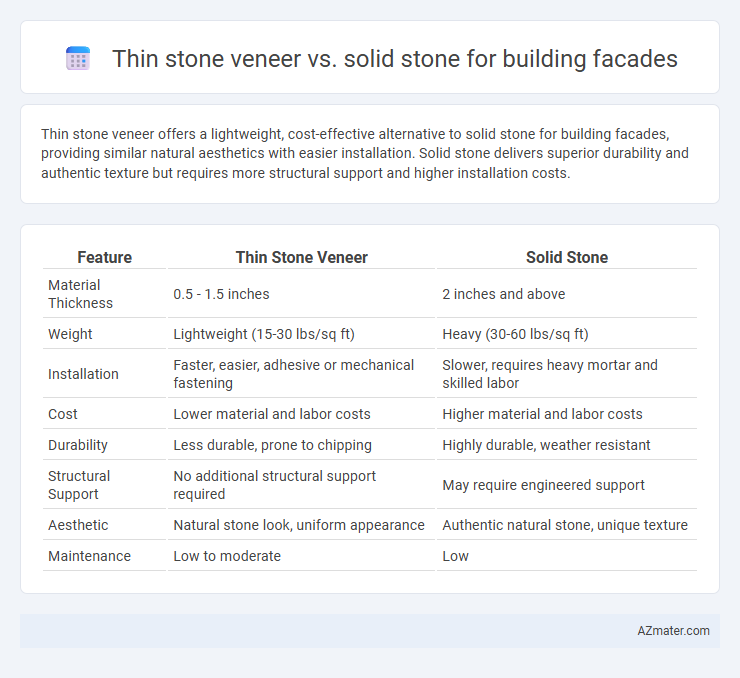Thin stone veneer offers a lightweight, cost-effective alternative to solid stone for building facades, providing similar natural aesthetics with easier installation. Solid stone delivers superior durability and authentic texture but requires more structural support and higher installation costs.
Table of Comparison
| Feature | Thin Stone Veneer | Solid Stone |
|---|---|---|
| Material Thickness | 0.5 - 1.5 inches | 2 inches and above |
| Weight | Lightweight (15-30 lbs/sq ft) | Heavy (30-60 lbs/sq ft) |
| Installation | Faster, easier, adhesive or mechanical fastening | Slower, requires heavy mortar and skilled labor |
| Cost | Lower material and labor costs | Higher material and labor costs |
| Durability | Less durable, prone to chipping | Highly durable, weather resistant |
| Structural Support | No additional structural support required | May require engineered support |
| Aesthetic | Natural stone look, uniform appearance | Authentic natural stone, unique texture |
| Maintenance | Low to moderate | Low |
Introduction: Comparing Thin Stone Veneer and Solid Stone
Thin stone veneer offers a lightweight, cost-effective alternative to solid stone for building facades, providing aesthetic appeal with easier installation and reduced structural load. Solid stone delivers unmatched durability, natural weather resistance, and a timeless appearance, making it ideal for historic or high-end architectural projects. Comparing these materials involves assessing factors such as installation complexity, longevity, maintenance, and overall project budget.
Material Composition and Characteristics
Thin stone veneer consists of natural stone slices, typically 1 to 2 centimeters thick, bonded to a backing material for lightweight installation, whereas solid stone comprises full-thickness quarried blocks, often exceeding 5 centimeters in thickness, providing superior durability and structural integrity. Thin stone veneer offers a variety of finishes and is easier to handle and install, making it ideal for decorative facades, while solid stone delivers enhanced weather resistance, load-bearing capacity, and longevity for demanding architectural applications. The porous nature and density of solid stone limit moisture penetration, contrasting thin stone veneer which requires proper sealing to prevent water damage and maintain facade performance.
Installation Process and Techniques
Thin stone veneer offers a lightweight solution ideal for faster installation with less structural support, using adhesive or mechanical fasteners on a variety of substrates. Solid stone requires heavy machinery for cutting and lifting, with traditional mortar beds or anchoring systems that demand skilled labor and extended curing times. The veneer method reduces construction time and complexity, while solid stone ensures greater durability but involves more intensive installation techniques.
Structural Requirements and Support
Thin stone veneer requires a lighter structural support system compared to solid stone, as it typically weighs between 15 to 30 pounds per square foot, reducing the load on building frameworks. Solid stone, with weights ranging from 100 to 150 pounds per square foot, demands a robust structural framework, including reinforced steel or concrete to support its significant mass. Engineering considerations for thin veneer often include metal lath or adhesive anchoring systems, whereas solid stone mandates load-bearing walls designed to accommodate its heavy, compressive forces.
Aesthetic Appeal and Design Flexibility
Thin stone veneer offers superior design flexibility compared to solid stone, allowing for easier installation on curved surfaces and intricate architectural details while maintaining the natural texture and rich color variations of authentic stone. Its lightweight nature enables creative facade designs with varied patterns, shapes, and finishes, enhancing aesthetic appeal without the structural constraints of solid stone. Solid stone provides unmatched durability and a timeless, robust appearance but limits design versatility due to its thickness and weight, often resulting in more traditional, uniform facade applications.
Cost Comparison and Budget Considerations
Thin stone veneer typically costs significantly less than solid stone due to reduced material weight and easier installation processes, lowering labor expenses. Solid stone demands a higher initial investment because of its durability, thickness, and structural support requirements, which can increase both material and labor costs. Budget-conscious projects often favor thin veneer for its cost efficiency while maintaining an authentic stone appearance without the substantial financial outlay of solid stone.
Durability and Longevity
Thin stone veneer offers a lightweight option with good durability but generally has a shorter lifespan compared to solid stone, which provides exceptional strength and longevity due to its natural density and resistance to weathering. Solid stone facades can withstand harsh environmental conditions and require minimal maintenance, often lasting over a century without significant deterioration. Thin stone veneer may be more prone to chipping and delamination but remains a cost-effective alternative when properly installed with quality substrates and sealants.
Maintenance and Upkeep
Thin stone veneer requires significantly less maintenance than solid stone due to its lighter weight and ease of replacement, which minimizes structural stress on building facades. Solid stone, while durable, often demands more intensive upkeep including frequent sealing, cleaning, and potential repairs due to its thickness and exposure. Both materials benefit from periodic inspection, but thin stone veneer offers a cost-effective and less labor-intensive solution for long-term facade maintenance.
Environmental Impact and Sustainability
Thin stone veneer significantly reduces environmental impact compared to solid stone by using less raw material and decreasing transportation emissions due to its lighter weight. Its installation demands less energy and reduces waste generation, enhancing overall sustainability for building facades. Solid stone, while durable, requires intensive quarrying and higher transport energy, leading to greater carbon footprint and resource depletion.
Applications and Suitability for Different Projects
Thin stone veneer offers lightweight installation ideal for residential and commercial facades where structural load is limited, making it suitable for renovations and new builds requiring aesthetic appeal with cost efficiency. Solid stone provides superior durability and natural weather resistance, preferred for heritage restorations, high-traffic urban environments, and projects demanding long-lasting, robust facade materials. Choosing between thin stone veneer and solid stone depends on the project's structural capacity, budget, and desired longevity, with thin veneer excelling in flexibility and solid stone excelling in strength.

Infographic: Thin stone veneer vs Solid stone for Building facade
 azmater.com
azmater.com